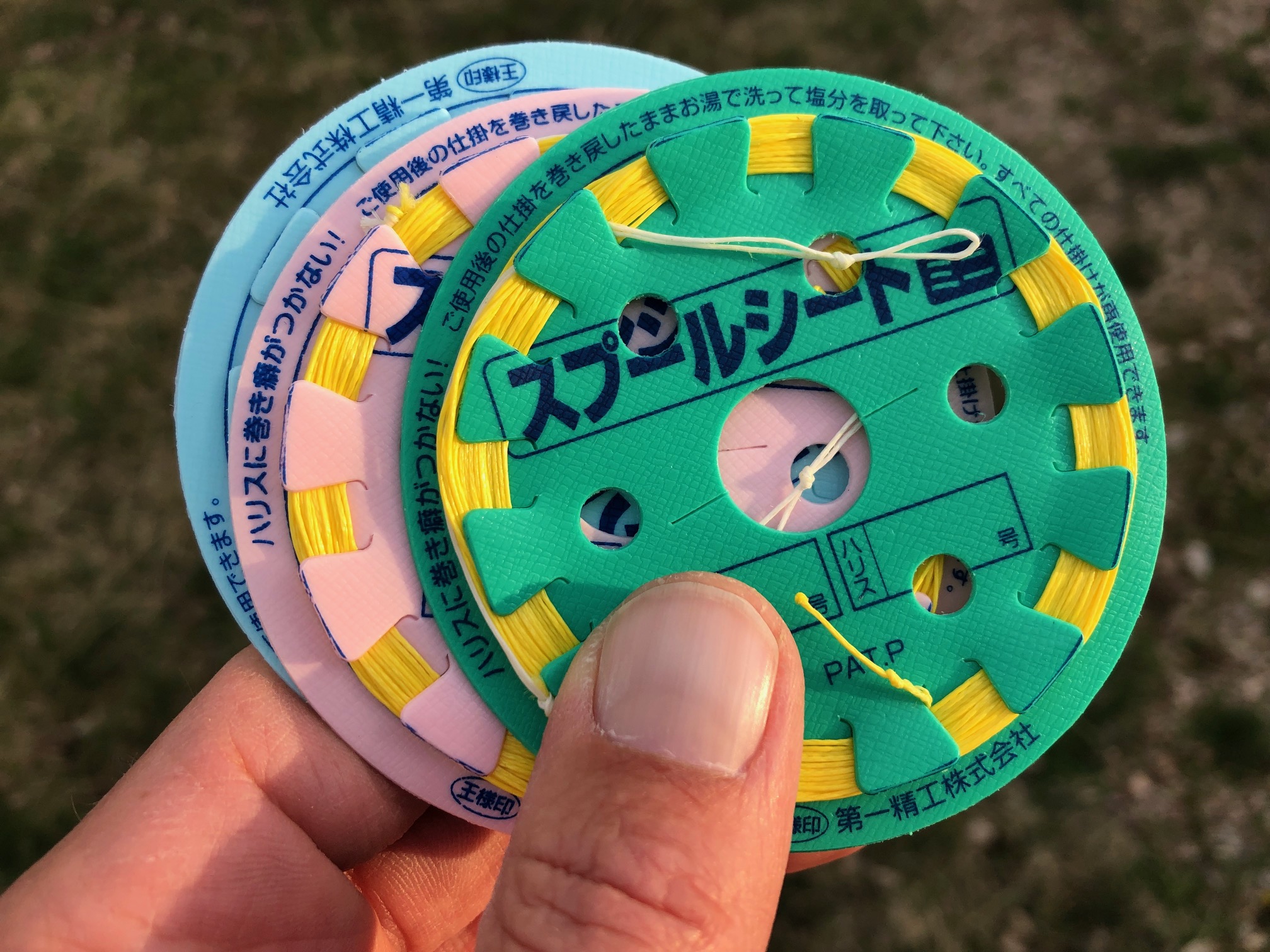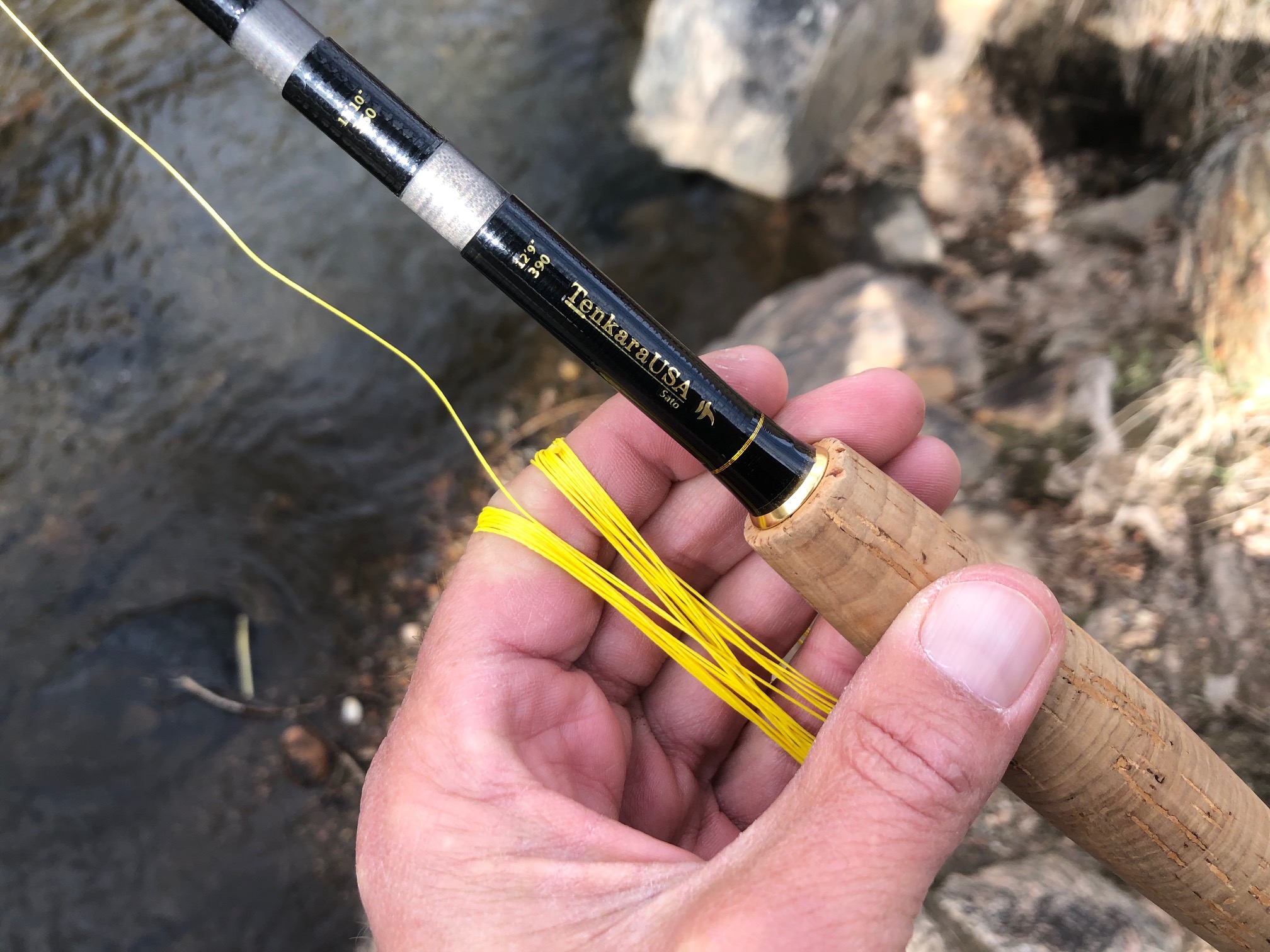
One of the things I love about tenkara is that it lends itself to DIY gear and experimentation–especially when it comes to lines. If you think about it, people don’t really do much in the way of DIY lines in mainstream fly fishing. Most people just buy something off the shelf and while they might experiment with different models, they’re not sitting in their basements splicing lines together to create their own tapers and certainly aren’t experimenting with unorthodox materials (although I’ll admit there is an small, esoteric bunch who does). While I mostly use off-the-shelf level fluorocarbon lines, over the years, I’ve also experimented with a variety of materials that weren’t intended or designed for tenkara, but turned out to work quite well. One that I’ve been exploring for a while is HMPE line and I’m now confident enough in its performance, I thought it was time to share.
You probably have no idea what “HMPE” is but I bet if I mentioned it by two of its brand names you would: Spectra and Dyneema. “HMPE” stands for “high modulous polyethylene” and is the stuff used to make bulletproof vests (hence the name I give this line). In recent years, braided HMPE has come into favor for conventional fishing because of its unique properties and because of those same properties, it happens to be apt for tenkara as well.

There are many different brands widely available in many tackle stores, but I chose Bass Pro Shops Hyperbraid because it’s less expensive than others and comes in a high-vis yellow color (some other brands are only available in white or stealth green).

To attach to the rod, I just tied a 20 lb. Dacron loop to tie to the lilian with a girth-hitch connection.
 And for the tippet end, I just tied a figure-8 stopper knot to be connected with the tenkara one knot. Tip: burn the tag end with a lighter so it doesn’t fray.
And for the tippet end, I just tied a figure-8 stopper knot to be connected with the tenkara one knot. Tip: burn the tag end with a lighter so it doesn’t fray.

Lengths
I’ve tried it in several lengths and have settled on 13′, 16′ and 20′. Most of my fishing is on small streams where the 20′ would be overkill so I typically end up using the 13′ line on a 12′ or 13′ rod and sometimes the 16′ line on longer or stiffer rods. The 20′ is better for larger waters or stillwaters.

Diameter
You might have noticed that the picture above shows that I’m using the 65 lb. test line. I chose this not for the tensile strength, but for the diameter. I’m sure there are situations where a lighter or heavier line might be appropriate, but for me, the 65 lb. seems to strike the Goldilocks balance of mass for turnover and diameter for visibility without being so thick that it creates aerodynamic resistance which would make it difficult to cast in the wind.
Advantages of HMPE Line
- Turnover. Because it has more mass than typical level fluorocarbon, this line turns over more like a conventional PVC fly line. It loads rods more easily and turns over with a tight loop. It’s also got the horsepower to cut through the wind well.
- Amnesia. Since the braided fibers are supple, there is no memory and so you don’t have to stretch any coils out before casting.
- Sensitivity. Because it doesn’t stretch (well, not significantly at any practical length for tenkara purposes), strike detection by feel is enhanced making it an excellent choice for nymph or streamer fishing.
- Durability. You’ve probably already guessed that given what it’s made from, this line is nearly indestructible.
- Visibility. Since it’s opaque, thick (compared to typical fluorocarbon lines), and bright yellow, this line is highly visible across a variety of lighting conditions facilitating visual strike indication.

Disadvantages of HMPE Line
- Drift & drag. I wasn’t sure whether to put this under advantages or disadvantages. On the one hand, despite how heavy it is, HMPE is still relatively easy to keep off the water for a dead drift–but this is only true in shorter lengths. In longer lengths, it will start to lay on the water more like a PVC fly line. So I suppose I’ll leave it to you to put that under whichever category you think more appropriate.
- Because it’s thicker and so high-vis, this is not a line that you’d want to use where extreme stealth is required. The fish will easily see it in slow, clear water if it’s cast over them and it doesn’t make as delicate a landing on the water as fluorocarbon does. So it’s better suited to faster water with some disturbance on the surface.
- Even though the HMPE itself doesn’t absorb water, the space in between the braided strands does. That is, the line doesn’t float. So that pretty much limits it to fishing subsurface flies. It’s not a great choice for dry fly fishing. In fact, after it gets wet and picks up water, it will slowly turn into a somewhat of a “sink-tip” which (depending on your application) could actually be an advantage.
- If you happen to get a bad wind knot or really nebulous tangle, it will be more difficult to get out than fluorocarbon line. I’m not sure why–it probably has something to do with the braid and how it cinches up on itself. I might be overstating this a little–I think it would be rare that you would get a tangle so bad that you’d have to scrap the whole line. But I just noticed it’s not as easy to untangle as fluorocarbon so thought I would mention it.

Conclusion
Will this replace my fluorocarbon lines? No. They’ll remain my go-to lines. But it is a great line and I wouldn’t feel cheated if, one day, I happened to have forgotten all of my fluorocarbon lines at home and were forced to fish with an HMPE line. If you like to experiment, it would be worth your money to pick up a spool and start testing. You might not end up replacing your “go-to”, but at worst, you’ll come up with a specialty line that fills a niche in your arsenal.








Heavy. But may be good for windy conditions.
You know I love the diy and this line looks incredible. I will have to try some soon.
What fluorocarbon do you use and what pound?
Thanks great review on the HMPE.
Eddie
Hey Eddie, are you asking about which fluorocarbon I use as the main tenkara line or for the tippet?
Does anyone know, is this Bass Pro Shops XPS Hyper Braid Fishing Line available in Europe area/ shop?
Ari, send me your address and I’ll send you some.
… as polyethylene density is lower than water, between 0.94 up to 0.97 g/cc, hmpe should float regardless water soaking… so that maybe there are other factors as impurities interfering, for instance… should you consider rinsing the line or dressing it with a proper product from time to time?
I wouldn’t use any kind of dressing on this. It may pick up dirt that gets into the weave and would be difficult to get out.
In Australia there is limited sources for tenkara and getting anything here is expensive, so being thrifty, smart, resourceful and experimenting is required. This post inspired me and I ended up buying Daiwa J-braid x8 spectra line in 50lb (.36mm) in chartreuse.
I used 11ft line, 20lb dacron backing for the lillian attachment, and 3ft of 4x tippet to size 12 royal wulff. We’ll see how it performs in the field.
Big thanks to this blog as its helped immensely with understanding Tenkara 101. Tight lines from Down Under.
I’m curious as to why people add 20 lb dacron for the connection to the Lillian when using braided line. Why not just add the loop to the braided line and connect directly to the lillian?
Some companies do off that. The problem is that the butt of the line is thicker than Dacron and doesn’t grip as well. Dacron (or lilian cord) just cinches up better against the lilian on the rod.
Hello, Jason, greetings from a fellow New Yorker. Like you, I moved to Colorado (over 40yrs.ago). I got back into Tenkara after a few years, am into it big time now. Next trip to the Fla. Keys, will try it out on bonefish. Any suggestions? You’re my go to guy on the subject and I like your style. I have a lot of your posts on pinterest and think they’re excellent. Stay cool (in the 90’s today).
Hi Keith,
That’s great to hear that you’re back into it! On bonefish, I use a rod and reel. I use tenkara for mountain stream trout. In other words, I use the right tool for the right job (what they were designed for). So if you want my suggestion, it’s to do the same. Plus, to me, hearing the reel scream is one of the thrills of flats fishing! Why would you want to miss out on that? And it sucks to cast bonefish flies with a tenkara rod. You’ve got the weighted eyes, and there’s almost always wind on the flats. I’ve tried it and hated it. It’s not an enjoyable way to fish. And bonefish are hard enough to catch as it is. Why would you want to put yourself at a disadvantage? Not trying to dissuade you, but you asked and that’s my answer.
Hello Jason, amigo, thanks for your reply, and I will definitely follow your advice. I’ll use the tenkara for needlefish and regular gear for bonefish. Needlefish are fun to catch on light rods just be careful removing the fly, which I always crimp the barb on. More humane. Catch the big ones, Zorro
Again, not telling you not to try it. That’s just my opinion. Have fun and let me know what you catch!
Hi Jason,
Good informative article! I’ve tried HMPE lines in much lighter sizes and had some tangle and casting problems but it otherwise fished well. I’ll try 65 lb..
For the past 5 or 6 years I have been using Varivas AIRS 24 pound test shooting line for my mostly nymphing setup tenkara lines. It is an air-core monofilament, so it floats well and is much lighter than other coated floating tenkara or Euro nymphing lines, with less line sag. I keep trying other line materials but keep coming back to the Varivas AIRS. Can be found in clear yellow or orange and also in larger sizes. Down-sides: It’s less visable than your yellow line and kinks up on line spools some but is easy to stretch straight.
Hi Larry,
You know, after all the lines I’ve tried, I still keep coming back to regular old Nissin PALS or Tenkara USA fluorocarbon level line. It just works for all the situations I typically face and now I’m just so used to casting it, it feels like second nature. But you’ve got to experiment, right‽ Even though my go-to in level line, I still play with different ones. In fact, I just got two lines from Zen Outfitters that look very interesting. I haven’t fished them yet but they’re braided level lines. I’ll have a quick review after I do.